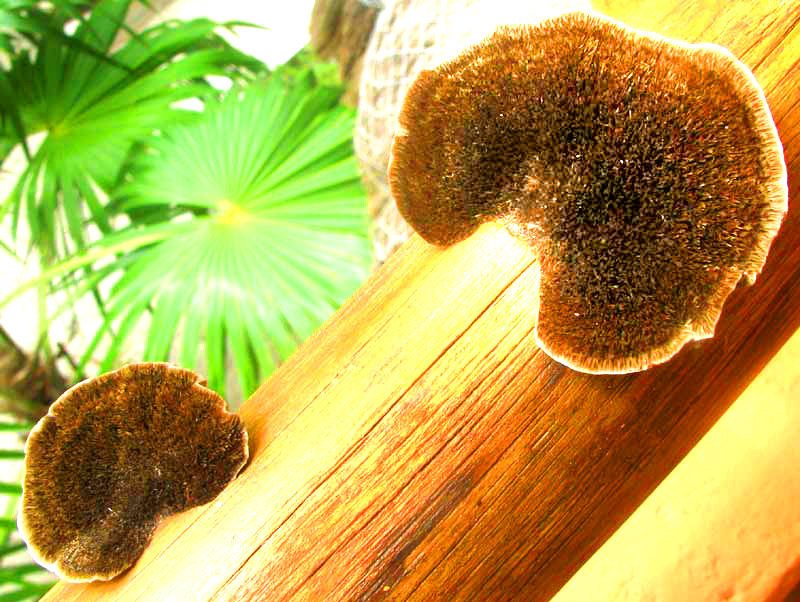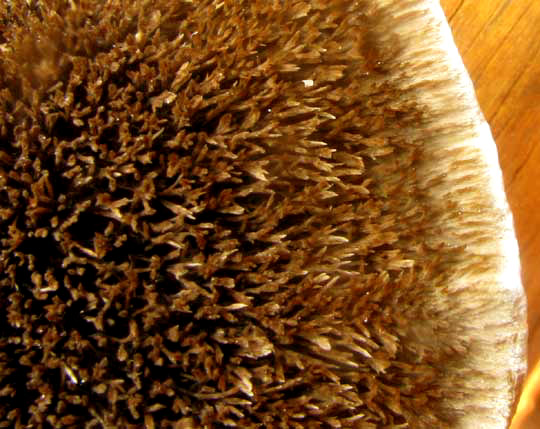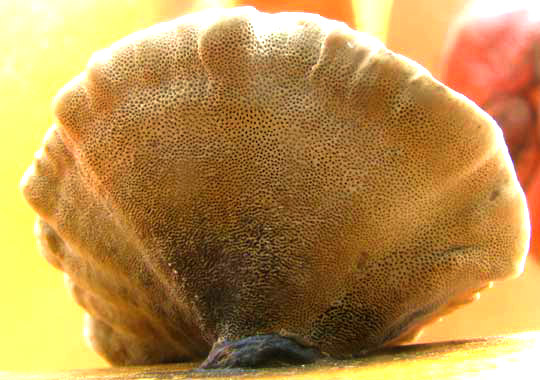Excerpts from Jim Conrad's
Naturalist Newsletter

from the June 26, 2011 Newsletter issued from Mayan Beach Garden Inn 20 kms north of Mahahual; Caribbean coastal beach and mangroves, ~N18.89°, ~W87.64°, Quintana Roo state, MÉXICO
MANGROVE POLYPORE
We've seen that the relatively arid Yucatán is not a great place for mushrooms. Therefore, I had mixed feelings the other day when a couple of ear-shaped mushrooms suddenly appeared on a prettily varnished wooden railing that keeps me from falling off the observation deck of my second-story room. You can see them -- the larger 2.5 inches across (55mm) -- above.
Such ear-shaped mushrooms are commonly referred to as shelf or bract fungi. In North America probably the best known shelf fungi are the banded little "Turkey- tails" frequently seen on logs in the woods. A feature of my railing fungus distinguishing it from most other shelf fungi was that its cap was thickly wooly with brown, hairlike, outward-leaning scales, as you can see below:

Mushrooms reproduce by spores typically formed on closely spaced gills on the mushroom cap's underside. Our railing fungus, instead of having gills on its undersurface, had many closely-packed pores, as shown below:

In that picture, shot from below, not only can you see the fungus's dark-based, off-center stem but also my own shiny noggin as I peered down from above. When you see such a fungal body with pores instead of gills, usually you have one of two big mushroom groups. If the fruiting body has a regular "mushroom shape," with a central stem, then most likely it's a member of the Boletus Family, the Boletaceae, many of which are good eating. If the mushroom has no stem or a very off- center stem, like ours, it's a member of the Polypore Family, the Polyporaceae, of which most are too tough to eat.
So, I began Googling tropical members of the Polypore Family and before long came up with an ID: Here we have DATRONIA CAPERATA, which grows on dead wood in the American and African tropics. It's a variable species usually recognized in the field by its cap being covered by long, slender, dark brown scales. The species may have a special fondness for mangrove swamps. In our mangroves it's the only fungus I've seen yet, growing on many standing trunks of trees killed by Hurricane Dean in 2007. I find no English name for it, but henceforward I'll be thinking of it as "Mangrove Polypore."
The big question was whether our Datronia caperatas was actively weakening the railing by consuming wood contributing to the railing's strength, or whether it was just feeding on the by products of other decay organisms in the wood, and therefore not really damaging the wood. I found a reference saying that the species causes "dry rot," and at least one definition of dry rot is that the organism causing it digests parts of the wood which give the wood strength and stiffness. Therefore, what little I can find about Datronia caperata suggests that it's not to be welcomed on my railing.
Therefore, Marcia, I've already removed the two little mushrooms from your railing. However, mushrooms are nothing but the fruiting bodies, or reproductive structures, of a fungus, so the railing-eating fungal "body" remains behind inside the railing, probably to issue new mushrooms in the future.